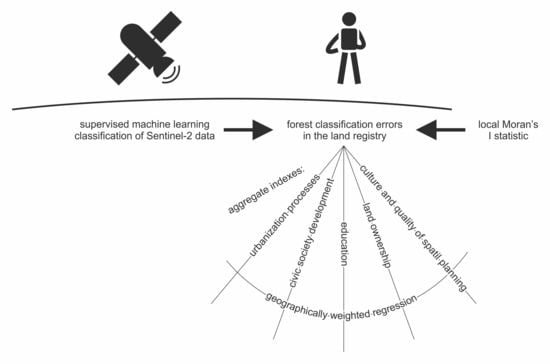Impairing Land Registry: Social, Demographic, and Economic Determinants of Forest Classification Errors
Abstract
1. Introduction
2. Literature Review and Hypotheses
2.1. Urbanization Processes Influencing Classification Errors in Land Registers
2.2. Impact of the Condition of Civic Society on Data Quality in Land Registers
2.3. Education Level and Its Influence on Errors in Land Registers
2.4. Land Ownership and Land Registry Classification Errors
2.5. Relation between Culture of Spatial Planning and Data Quality in Land Registers
2.6. Hypotheses
3. Methods and Data Collection
3.1. Research Design
3.2. Data Sources
3.3. Methods of Analysis
4. Results and Discussion
4.1. Forest Cover
4.2. Errors of Forest Identification in the Land Registry
4.3. Determinants of Land Registry Errors
5. Conclusions
Author Contributions
Funding
Acknowledgments
Conflicts of Interest
References
- Boucher, Y.; Grondin, P.; Auger, I. Land use history (1840–2005) and physiography as determinants of southern boreal forests. Landsc. Ecol. 2014, 29, 437–450. [Google Scholar] [CrossRef]
- Pineda, J.N.B.; Bosque, S.J.; Gómez, D.M.; Franco, P.R. Exploring the driving forces behind deforestation in the state of Mexico (Mexico) using geographically weighted regression. Appl. Geogr. 2010, 30, 576–591. [Google Scholar] [CrossRef]
- Hu, X.; Wu, Z.; Wu, C.; Ye, L.; Lan, C.; Tang, K.; Xu, L.; Qiu, R. Effects of road network on diversiform forest cover changes in the highest coverage region in China: An analysis of sampling strategies. Sci. Total Environ. 2016, 565, 28–39. [Google Scholar] [CrossRef] [PubMed]
- Lossou, E.; Owusu-Prempeh, N.; Agyemang, G. Monitoring Land Cover changes in the tropical high forests using multi-temporal remote sensing and spatial analysis techniques. Remote Sens. Appl. Soc. Environ. 2019, 16, 100264. [Google Scholar] [CrossRef]
- Bhugeloo, A.; Peerbhay, K.; Ramdhani, S.; Sershen. Tracking indigenous forest cover within an urban matrix through land use analysis: The case of a rapidly developing African city. Remote Sens. Appl. Soc. Environ. 2019, 13, 328–336. [Google Scholar] [CrossRef]
- Gunggut, H.; Saufi, D.S.N.S.A.M.; Zaaba, Z.; Liu, M.S.-M. Where have All the Forests Gone? Deforestation in Land Below the Wind. Proced. Soc. Behav. Sci. 2014, 153, 363–369. [Google Scholar] [CrossRef]
- Singh, M. Evaluating the impact of future climate and forest cover change on the ability of Southeast (SE) Asia’s protected areas to provide coverage to the habitats of threatened avian species. Ecol. Indic. 2020, 114, 106307. [Google Scholar] [CrossRef]
- De Keersmaeker, L.; Onkelinx, T.; De Vos, B.; Rogiers, N.; Vandekerkhove, K.; Thomaes, A.; De Schrijver, A.; Hermy, M.; Verheyen, K. The analysis of spatio-temporal forest changes (1775–2000) in Flanders (northern Belgium) indicates habitat-specific levels of fragmentation and area loss. Landsc. Ecol. 2015, 30, 247–259. [Google Scholar] [CrossRef]
- Feranec, J.; Šuri, M.; Ot’ahel’, J.; Cebecauer, T.; Kolář, J.; Soukup, T.; Zdeňková, D.; Waszmuth, J.; Vâjdea, V.; Vîjdea, A.M.; et al. Inventory of major landscape changes in the Czech Republic, Hungary, Romania and Slovak Republic 1970s–1990s. ITC J. 2000, 2, 129–139. [Google Scholar] [CrossRef]
- Skaloš, J.; Engstová, B.; Trpáková, I.; Šantrůčková, M.; Podrázský, V. Long-Term changes in forest cover 1780–2007 in central Bohemia, Czech Republic. Eur. J. For. Res. 2012, 131, 871–884. [Google Scholar] [CrossRef]
- Wulf, M.; Sommer, M.; Schmidt, R. Forest cover changes in the Prignitz region (NE Germany) between 1790 and 1960 in relation to soils and other driving forces. Landsc. Ecol. 2010, 25, 299–313. [Google Scholar] [CrossRef]
- Jeon, S.B.; Olofsson, P.; Woodcock, C.E. Land use change in New England: A reversal of the forest transition. J. Land Use Sci. 2014, 9, 105–130. [Google Scholar] [CrossRef]
- Di Fazio, S.; Modica, G.; Zoccali, P. Evolution Trends of Land Use/Land Cover in a Mediterranean Forest Landscape in Italy BT—Computational Science and Its Applications—ICCSA 2011; Murgante, B., Gervasi, O., Iglesias, A., Taniar, D., Apduhan, B.O., Eds.; Springer: Berlin/Heidelberg, Germany, 2011; pp. 284–299. [Google Scholar]
- Puddu, G.; Falcucci, A.; Maiorano, L. Forest changes over a century in Sardinia: Implications for conservation in a Mediterranean hotspot. Agrofor. Syst. 2012, 85, 319–330. [Google Scholar] [CrossRef]
- Borowska-Stefańska, M.; Leśniewska-Napierała, K.; Wiśniewski, S. Land cover changes in Poland between 1990 and 2012. Geografie 2018, 123, 63–83. [Google Scholar] [CrossRef][Green Version]
- Leśniewska-Napierała, K.; Nalej, M.; Napierała, T. The Impact of EU Grants Absorption on Land Cover Changes—The Case of Poland. Remote Sens. 2019, 11, 2359. [Google Scholar] [CrossRef]
- Kozak, J.; Estreguil, C.; Vogt, P. Forest cover and pattern changes in the Carpathians over the last decades. Eur. J. For. Res. 2007, 126, 77–90. [Google Scholar] [CrossRef]
- Kozak, J.; Estreguil, C.; Ostapowicz, K. European forest cover mapping with high resolution satellite data: The Carpathians case study. Int. J. Appl. Earth Obs. Geoinf. 2008, 10, 44–55. [Google Scholar] [CrossRef]
- Szymura, T.H.; Unajski, A.; Ruczakowska, A.M. Zmiany powierzchni lasów na obszarze Karkonoskiego Parku Narodowego w okresie 1747–1977 [Changes of forest cover in the Karkonosze National Park area in 1747–1977 period]. Opera Corcon. 2010, 47, 159–166. [Google Scholar]
- Gielarek, S.; Klich, D.; Antosiewicz, M. Zmiany powierzchni leśnej w Bieszczadach Zachodnich w XIX i XX wieku [Forest cover change in Western Bieszczady Mts. in 19 th and 20 th century]. Sylwan 2011, 155, 835–842. [Google Scholar]
- Nalej, M. Agricultural land cover changes in metropolitan areas of Poland for the period 1990–2012. Misc. Geogr. 2016, 20, 39–45. [Google Scholar] [CrossRef][Green Version]
- Fiedeń, Ł. Changes in land use in the communes crossed by the A4 motorway in Poland. Land Use Policy 2019, 85, 397–406. [Google Scholar] [CrossRef]
- Pașca, A.; Năsui, D. The Use of CORINE Land Cover 2012 and Urban Atlas 2012 databases in agricultural spatial analysis. Case study: Cluj County, Romania. Res. J. Agric. Sci. 2016, 48, 314–322. [Google Scholar]
- Vanonckelen, S.; Rompaey, A. Van Spatiotemporal Analysis of the Controlling Factors of Forest Cover Change in the Romanian Carpathian Mountains. Mt. Res. Dev. 2015, 35, 338–350. [Google Scholar] [CrossRef]
- Gulinck, H.; Múgica, M.; De Lucio, J.V.; Atauri, J.A. A framework for comparative landscape analysis and evaluation based on land cover data, with an application in the Madrid region (Spain). Landsc. Urban Plan. 2001, 55, 257–270. [Google Scholar] [CrossRef]
- Teixido, A.L.; Quintanilla, L.G.; Carreño, F.; Gutiérrez, D. Impacts of changes in land use and fragmentation patterns on Atlantic coastal forests in northern Spain. J. Environ. Manag. 2010, 91, 879–886. [Google Scholar] [CrossRef]
- Valbuena-Carabaña, M.; de Heredia, U.L.; Fuentes-Utrilla, P.; González-Doncel, I.; Gil, L. Historical and recent changes in the Spanish forests: A socio-economic process. Rev. Palaeobot. Palynol. 2010, 162, 492–506. [Google Scholar] [CrossRef]
- Verburg, P.H.; Neumann, K.; Nol, L. Challenges in using land use and land cover data for global change studies. Glob. Chang. Biol. 2011, 17, 974–989. [Google Scholar] [CrossRef]
- Sylla, L.; Xiong, D.; Zhang, H.Y.; Bangoura, S.T. A GIS technology and method to assess environmental problems from land use/cover changes: Conakry, Coyah and Dubreka region case study. Egypt. J. Remote Sens. Sp. Sci. 2012, 15, 31–38. [Google Scholar] [CrossRef]
- Ciupa, T.; Suligowski, R.; Wałek, G. Zmiany w zasięgu lasów w Górach Świętokrzyskich w ostatnich 200 latach [Changes in forest coverage of the Holy Cross Mountains during last 200 years]. Eduk. Biol. Sr. 2016, 4, 16–23. [Google Scholar]
- Schaefer, M.; Thinh, N.X. Evaluation of Land Cover Change and Agricultural Protection Sites: A GIS and Remote Sensing Approach for Ho Chi Minh City, Vietnam. Heliyon 2019, 5, e01773. [Google Scholar] [CrossRef]
- Straume, K. The social construction of a land cover map and its implications for Geographical Information Systems (GIS) as a Management Tool. Land Use Policy 2014, 39, 44–53. [Google Scholar] [CrossRef]
- Liu, Z.; Zhang, T.; Yu, J.; Zhou, L. Determinants of rural households’ afforestation program participation: Evidence from China’s Ningxia and Sichuan provinces. Glob. Ecol. Conserv. 2019, 17, 1–14. [Google Scholar] [CrossRef]
- Patra, S.; Sahoo, S.; Mishra, P.; Mahapatra, S.C. Impacts of urbanization on land use /cover changes and its probable implications on local climate and groundwater level. J. Urban Manag. 2018, 7, 70–84. [Google Scholar] [CrossRef]
- Śleszyński, P.; Gibas, P.; Sudra, P. The Problem of Mismatch between the CORINE Land Cover Data Classification and the Development of Settlement in Poland. Remote Sens. 2020, 12, 2253. [Google Scholar] [CrossRef]
- Ünal, H.E.; Birben, Ü.; Bolat, F. Rural population mobility, deforestation, and urbanization: Case of Turkey. Environ. Monit. Assess. 2019, 191, 21. [Google Scholar] [CrossRef]
- Alig, R. Urbanization in the US: Land use trends, impacts on forest area, projections, and policy considerations. J. Resour. Energy Dev. 2010, 7, 35–60. [Google Scholar] [CrossRef]
- Cui, N.; Feng, C.-C.; Wang, D.; Li, J.; Guo, L. The Effects of Rapid Urbanization on Forest Landscape Connectivity in Zhuhai City, China. Sustainability 2018, 10, 3381. [Google Scholar] [CrossRef]
- Sejati, A.W.; Buchori, I.; Rudiarto, I. The Impact of Urbanization to Forest Degradation in Metropolitan Semarang: A Preliminary Study. IOP Conf. Ser. Earth Environ. Sci. 2018, 123, 012011. [Google Scholar] [CrossRef]
- De Clercq, E.M.; Clement, L.; De Wulf, R.R. Monte Carlo simulation of false change in the overlay of misregistered forest vector maps. Landsc. Urban Plan. 2009, 91, 36–45. [Google Scholar] [CrossRef]
- Seebach, L.; Strobl, P.; Vogt, P.; Mehl, W.; San-Miguel-Ayanz, J. Enhancing post-classification change detection through morphological post-processing—A sensitivity analysis. Int. J. Remote Sens. 2013, 34, 7145–7162. [Google Scholar] [CrossRef]
- Chmielewski, J. Problemy rozpraszania się zabudowy na obszarze metropolitalnym Warszawy [Problems of urban sprawl in the Warsaw metropolitan area]. Urbanista 2005, 7, 52–62. [Google Scholar]
- Makowska-Iskierka, M. Procesy Urbanizacyjne na Terenach Turystyczno-Wypoczynkowych Strefy Podmiejskiej Łodzi [The Urbanization Processes in the Tourist Destinations. Example of the Urban Fringe Zone of Łódź]; Łódzkie Towarzystwo Naukowe: Łódź, Poland, 2011. [Google Scholar]
- Janeczko, E.; Budnicka-Kosior, J.; Dąbrowski, R. The urbanisation processes and forest landscape on the example of the north part of the Mazowiecki Landscape Park (MPK). Miškininkystė ir Kraštotvarka. For. Landsc. Manag. 2017, 1, 35–40. [Google Scholar]
- Piussi, P. Expansion of European mountain forests. In Forests in Sustainable Mountain Development: A State of Knowledge Report for 2000; IUFRO Research Series 5; Price, M.F., Butt, N., Eds.; CABI Publishing: Wallingford, NY, USA, 2000; pp. 19–25. [Google Scholar]
- Gray, J.; Lämmerhirt, D. Data and the city—How can public data infrastructures change lives in urban regions? SSRN Electron. J. 2019. [Google Scholar] [CrossRef]
- McDougall, K. A Local-State Government Spatial Data Sharing Partnership Model to Facilitate Sdi Development; University of Melbourne: Victoria, Australia, 2006. [Google Scholar]
- Rajabifard, A.; Williamson, I.P. Spatial Data Infrastructures: Concept, SDI Hierarchy and Future Directions. In Proceedings of the Geomatics’ 80 Conference, Teheran, Iran, 29 April–2 May 2001; Available online: https://minerva-access.unimelb.edu.au/handle/11343/33897 (accessed on 18 June 2020).
- Bernhard, M. Civil Society after the First Transition: Dilemmas of Post-communist Democratization in Poland and Beyond. Communist Post Communist Stud. 1996, 29, 309–330. [Google Scholar] [CrossRef]
- Radzik-Maruszak, K.; Mieczkowska-Czerniak, K. From indifference to protest: Citizen activity at the local level in Poland. Ann. UMCS Politol. 2013, 20, 151–169. [Google Scholar]
- Letki, N. Socialization for participation? Trust, membership, and democratization in east-central Europe. Polit. Res. Q. 2004, 57, 665–679. [Google Scholar] [CrossRef]
- Kikosicka, K. Partycypacja społeczności lokalnej w planowaniu przestrzennym (przykład gminy Dąbrowice) [Local community participation in spatial planning (example municipalities Dąbrowice)]. Acta Univ. Lodz. Folia Geogr. Socio Oecon. 2014, 17, 97–113. [Google Scholar]
- Leśniewska-Napierała, K.; Napierała, T. Participatory budgeting: Creator or creation of a better place? Evidence from rural Poland. Bull. Geogr. Socio Econ. Ser. 2020, 48, 65–81. [Google Scholar] [CrossRef]
- Rymarczyk, E.; Parzych, P.; Szabat-Precikowska, A. Problematyka funkcjonowania ewidencji gruntów i budynków z punktu widzenia organu ją prowadzącego [The issue of the functioning land and buildings registration from the conducting perspective]. Infrastrukt. Ekol. Teren. Wiej. 2012, 1, 85–96. [Google Scholar]
- Wolny, B. Wybrane problemy aktualizacji danych ewidencji gruntów i budynków [Selected issues concerning updating of the register of lands and buildings]. Prz. Geod. 2005, 77, 14–17. [Google Scholar]
- Noszczyk, T.; Hernik, J. Potrzeba czynnego prowadzenia ewidencji gruntów i budynków [The Necessity to Keep Land and Property Registers in an Active Manner]. Infrastruct. Ecol. Rural. Areas 2017, I, 229–241. [Google Scholar] [CrossRef]
- Steudler, D.; Williamson, I.P. Evaluation of national land administration system in Switzerland—Case study based on a management model. Surv. Rev. 2005, 38, 317–330. [Google Scholar] [CrossRef]
- Walzer, M. Toward a Global Civil Society; Berghahn Books: Oxford, NY, USA, 1998. [Google Scholar]
- Norris, P. The Worldwide Digital Divide: Information Poverty, the Internet and Development; Cambridge University Press: Cambridge, UK, 2000. [Google Scholar]
- Jackson, G.; Perez-Diaz, V.M. The Return of Civil Society: The Emergence of Democratic Spain; Harvard University Press: Cambridge, MA, USA, 1993. [Google Scholar]
- Seligman, A. The Idea of Civil Society; Free Press: New York, NY, USA, 1992. [Google Scholar]
- Siemiński, W. Cele i zasady partycypacji społecznej w planowaniu przestrzennym—Przegląd literatury [Public participation in spatial planning as an element of city policy]. Człow. Środowisko 2007, 40, 77–93. [Google Scholar]
- Kohler-Koch, B.; Quittkat, C. What is civil society and who represents civil society in the EU? Results of an online survey among civil society experts. Policy Soc. 2009, 28, 11–22. [Google Scholar] [CrossRef]
- Banks, N.; Hulme, D. The Role of NGOs and Civil Society in Development and Poverty Reduction. Brooks World Poverty Institute Working Paper. 2012, p. 171. Available online: https://ssrn.com/abstract=2072157 (accessed on 18 June 2020).
- Healey, P. Planning through debate: The communicative turn in planning theory. Town Plan. Rev. 1992, 63, 143–162. [Google Scholar] [CrossRef]
- Howe, J.; Langdon, C. Towards a Reflexive Planning Theory. Plan. Theory 2002, 1, 209–225. [Google Scholar] [CrossRef]
- Strzelecki, A. The Development of Participation Budget in the Civic Society of Kujawsko-Pomorskie Voivodship. Law Adm. Post Soviet Eur. 2018, I, 52–63. [Google Scholar] [CrossRef][Green Version]
- Leśniewska-Napierała, K. Budżet partycypacyjny jako narzędzie finansowania inwestycji w Łodzi [Participatory budget as a tool for financing investments in Łódź]. Stud. Miej. 2017, 25, 107–119. [Google Scholar] [CrossRef]
- Pietraszko-Furmanek, I. Partycypacja Społeczna w Środowiskach Lokalnych [Public Participation in Local Communities]; Krakowskie Towarzystwo Edukacyjne: Krakow, Poland, 2012; ISBN 9788375712605. [Google Scholar]
- Wendt, J.A. Wymiar Przestrzenny Struktur i Aktywności Społeczeństwa Obywatelskiego w Polsce [Spatial Aspect of the Structures and Activities of Civil Society in Poland]; IGiPZ PAN: Warsaw, Poland, 2007. [Google Scholar]
- Tasaki, T.; Kameyama, Y. Sustainability Indicators: Are We Measuring What We Ought to Measure? Glob. Environ. Res. 2015, 19, 147–154. [Google Scholar]
- Putnam, R.D. Social Capital: Measurement and Consequences. Can. J. Policy Res. 2001, 2, 41–51. [Google Scholar]
- Balaceanu, C.; Apostol, D.; Penu, D. Sustainability and Social Justice. Proced. Soc. Behav. Sci. 2012, 62, 677–681. [Google Scholar] [CrossRef]
- Woolcock, M.; Narayan, D. Social Capital: Implications for Development Theory, Research, and Policy. World Bank Res. Obs. 2000, 15, 225–249. [Google Scholar] [CrossRef]
- Brodie, E.; Cowling, E.; Nissen, N.; Ellis Paine, A.; Jochum, V.; Warburton, D. Understanding Participation: A Literature Review; National Council for Voluntary Organisations: London, UK, 2009. [Google Scholar]
- Grabowska, M.; Szawiel, T. Budowanie Demokracji. Podziały Społeczne, Partie Polityczne i Społeczeństwo Obywatelskie w Postkomunistycznej Polsce [Building Democracy. Social Divisions, Political Parties and Civil Society in Post-Communist Poland]; PWN: Warsaw, Poland, 2003. [Google Scholar]
- Stewart, S.; Dollbaum, J.M. Civil society development in Russia and Ukraine: Diverging paths. Communist Post Communist Stud. 2017, 50, 207–220. [Google Scholar] [CrossRef]
- Gumkowska, M.; Herbst, J.; Huszcz, J. Społeczny Kontekst Rozwoju Ekonomii Społecznej w Polsce—Raport z Badania [Social Context of the Development of the Social Economy in Poland—Research Report]; Fundacja Inicjatyw Społeczno-Ekonomicznych: Warsaw, Poland, 2006. [Google Scholar]
- Czapiński, J.; Panek, T. Social Diagnosis 2003; Wyższa Szkoła Finansów i Zarządzania: Białystok, Poland, 2003. [Google Scholar]
- Kalaitzidakis, P.; Mamuneas, T.P.; Savvides, A.; Stengos, T. Measures of human capital and nonlinearities in economic growth. J. Econ. Growth 2001, 6, 229–254. [Google Scholar] [CrossRef]
- Janc, K.; Czapiewski, K. Wykształcenie czynnikiem wspierającym rozwój gospodarczy obszarów wiejskich [Education as a Factor Supporting the Economic Development of Rural Areas]. Stud. Obsz. Wiej. 2005, 8, 69–84. [Google Scholar]
- Brach, M.; Karaszkiewicz, W.; Olenderek, H. Nowa Koncepcja Określania Działki Ewidencyjnej dla Gruntów w Zarządzie PGL Lasy Państwowe [New Concept of Registered Parcel Determination for Areas in the Property of the State Forests National Forest Holding]. Sylwan 2015, 159, 883–892. [Google Scholar] [CrossRef]
- Łuczyński, R. Technologiczne i prawne aspekty wznawiania oraz ustalania przebiegu granic działek ewidencyjnych [Technological and legal aspects of marking out and delimitation of borders of lands parcels]. Acta Sci. Pol. Geod. Descr. Terr. 2009, 8, 23–38. [Google Scholar]
- Felcenloben, D. Granice działki ewidencyjnej desygnatem wiarygodności publicznej katastru nieruchomości—Propozycje zmiany obowiązującego modelu [Borders of a cadastral parcel as a qualifier of social reliability of a real estate cadastre—Proposals of modifications of. Prz. Geod. 2010, 82, 9–13. [Google Scholar]
- Williamson, I.P.; Enemark, S.; Wallace, J.; Rajabifard, A. Land Administration for Sustainable Development; Esri Press: New York, NY, USA, 2009. [Google Scholar]
- Ghimbasan, A.C.; Vorovencii, I. Situation of cadaster and land registry at european and national level. Stud. Univ. Vasil. Gold. Stiint. Ing. Agro Tur. 2017, 12, 27–32. [Google Scholar]
- Busko, M.; Meusz, A. Current status of real estate cadastre in Poland with reference to historical conditions of different regions of the country. Environ. Eng. Proc. Int. Conf. Environ. Eng. ICEE 2014, 9, 1–8. [Google Scholar]
- Bennett, R.; Rajabifard, A.; Williamson, I.; Wallace, J. On the need for national land administration infrastructures. Land Use Policy 2012, 29, 208–219. [Google Scholar] [CrossRef]
- Felcenloben, D. Kryteria oceny jakości danych i informacji, gromadzonych i udostępnianych z katastru nieruchomości [Criteria for assessing the quality of data and information collected and shared from the real estate cadastre]. Prz. Geod. 2011, 83, 11–17. [Google Scholar]
- Zwirowicz, K. Wybrane problemy ekonomiczno-techniczne wykorzystywania danych ewidencyjnych na potrzeby związane z użytkowaniem ziemi [Selected Economic and Technical Aspects of the Use of Cadastral Data for the Purpose of Land Use]. Stud. Mater. Tow. Nauk. Nieruchom. 2010, 18, 67–76. [Google Scholar]
- Felcenloben, D. Ocena Jakości Danych Ewidencyjnych Oraz Efektywności Funkcjonowania Katastru Nieruchomości [Assessment of Registration Data Quality and the Efficiency of Functioning of the Real Estate Cadastre]; University of Environmental and Life Science: Wrocław, Poland, 2015. [Google Scholar]
- Dz.U. 1989 nr 30 poz. 163, Ustawa z dnia 17 maja 1989 r. In Prawo Geodezyjne i Kartograficzne [Geodetic And Cartographic Law of 17 May 1989]; The President of the Council of Ministers: Warsaw, Poland, 1989.
- Dz.U. 2001 nr 38 poz. In 454, Rozporządzenie Ministra Rozwoju Regionalnego i Budownictwa z Dnia 29 Marca 2001 r. w Sprawie Ewidencji Gruntów i Budynków; The President of the Council of Ministers: Warsaw, Poland, 2001.
- Budkowski, S.; Litwin, U. Issue of quality and reliability of spatial records information in the context of data concerning boundary points. Geomat. Landmanag. Landsc. 2018, 3, 35–44. [Google Scholar] [CrossRef]
- Kussul, N.; Lavreniuk, M.; Skakun, S.; Shelestov, A. Deep Learning Classification of Land Cover and Crop Types Using Remote Sensing Data. IEEE Geosci. Remote Sens. Lett. 2017, 14, 778–782. [Google Scholar] [CrossRef]
- Kamilaris, A.; Prenafeta-Boldú, F.X. A review of the use of convolutional neural networks in agriculture. J. Agric. Sci. 2018, 156, 312–322. [Google Scholar] [CrossRef]
- Liu, C.; Zeng, D.; Wu, H.; Wang, Y.; Jia, S.; Xin, L. Urban Land Cover Classification of High-Resolution Aerial Imagery Using a Relation-Enhanced Multiscale Convolutional Network. Remote Sens. 2020, 12, 311. [Google Scholar] [CrossRef]
- Krysiak, S.; Papińska, E.; Majchrowska, A.; Adamiak, M.; Koziarkiewicz, M. Detecting Land Abandonment in Łódź Voivodeship Using Convolutional Neural Networks. Land 2020, 9, 82. [Google Scholar] [CrossRef]
- Hu, Y.; Zhang, Q.; Zhang, Y.; Yan, H. A Deep Convolution Neural Network Method for Land Cover Mapping: A Case Study of Qinhuangdao, China. Remote Sens. 2018, 10, 2053. [Google Scholar] [CrossRef]
- Ronneberger, O.; Fischer, P.; Brox, T. U-Net: Convolutional Networks for Biomedical Image Segmentation. arXiv 2015, arXiv:1505.04597v1. [Google Scholar]
- Lin, T.-Y.; Dollar, P.; Girshick, R.; He, K.; Hariharan, B.; Belongie, S. Feature Pyramid Networks for Object Detection. In Proceedings of the 2017 IEEE Conference on Computer Vision and Pattern Recognition (CVPR), Honolulu, HI, USA, 21–26 July 2017; pp. 936–944. [Google Scholar]
- Chaurasia, A.; Culurciello, E. LinkNet: Exploiting Encoder Representations for Efficient Semantic Segmentation. IEEE VCIP 2017. [Google Scholar] [CrossRef]
- Zhao, H.; Shi, J.; Qi, X.; Wang, X.; Jia, J. Pyramid Scene Parsing Network. IEEE CVPR 2017. [Google Scholar] [CrossRef]
- Mazzia, V.; Khaliq, A.; Chiaberge, M. Improvement in Land Cover and Crop Classification based on Temporal Features Learning from Sentinel-2 Data Using Recurrent—Convolutional Neural Network (R-CNN). Appl. Sci. 2020, 10, 238. [Google Scholar] [CrossRef]
- Dz.U. 1991 nr 101 poz. In 444, Ustawa z Dnia 28 Września 1991 r. o Lasach [Forest Act of 28 September 1991]; The President of the Council of Ministers: Warsaw, Poland, 1991.
- Rocznik Statystyczny Leśnictwa [Statistical Yearbook of Forestry]; Główny Urząd Statystyczny [Statistics Poland]: Warsaw, Poland, 2018.
- Dz.U. 2011 nr 279 poz. In 1642, Rozporządzenie MSWiA z Dnia 17 Listopada 2011 r. w Sprawie Bazy Danych Obiektów Topograficznych Oraz Bazy Danych Obiektów Ogólnogeograficznych, a Także Standardowych Opracowań Kartograficznych; The President of the Council of Ministers: Warsaw, Poland, 2011.
- Majewska, J. Inter-Regional agglomeration effects in tourism in Poland. Tour. Geogr. 2015, 17, 408–436. [Google Scholar] [CrossRef]
- Majewska, J.; Napierała, T.; Adamiak, M. Wykorzystanie nowych technologii i informacji do opisu przestrzeni turystycznej [Using New Information and Communication Technologies for the Description of Tourism Space]. Folia Tur. 2016, 41, 309–339. [Google Scholar]
- Saisana, M.; Tarantola, S. State-Of-The-Art Report on Current Methodologies and Practices for Composite Indicator Development; European Commission Joint Research Centre, Institute for the Protection and the Security of the Citizen Technological and Economic Risk Management Unit: Ispra, Italy, 2002. [Google Scholar]
- Brown, S.; Versace, V.L.; Laurenson, L.; Ierodiaconou, D.; Fawcett, J.; Salzman, S. Assessment of Spatiotemporal Varying Relationships Between Rainfall, Land Cover and Surface Water Area Using Geographically Weighted Regression. Environ. Model. Assess. 2012, 17, 241–254. [Google Scholar] [CrossRef]
- Gao, J.; Li, S. Detecting spatially non-stationary and scale-dependent relationships between urban landscape fragmentation and related factors using Geographically Weighted Regression. Appl. Geogr. 2011, 31, 292–302. [Google Scholar] [CrossRef]
- Shariff, N.M.; Gairola, S.; Talib, A. Modelling urban land use change using geographically weighted regression and the implications for sustainable environmental planning. In Proceedings of the Modelling for Environment’s Sake: Proceedings of the 5th Biennial Conference of the International Environmental Modelling and Software Society, iEMSs 2010, Ottawa, ON, Canada, 5–8 July 2010; Available online: https://scholarsarchive.byu.edu/cgi/viewcontent.cgi?article=2330&context=iemssconference (accessed on 18 June 2020).
- Taghipour Javi, S.; Malekmohammadi, B.; Mokhtari, H. Application of geographically weighted regression model to analysis of spatiotemporal varying relationships between groundwater quantity and land use changes (case study: Khanmirza Plain, Iran). Environ. Monit. Assess. 2014, 186, 3123–3138. [Google Scholar] [CrossRef]
- Huang, J.; Huang, Y.; Pontius, R.G.; Zhang, Z. Geographically weighted regression to measure spatial variations in correlations between water pollution versus land use in a coastal watershed. Ocean Coast. Manag. 2015, 103, 14–24. [Google Scholar] [CrossRef]
- Su, S.; Xiao, R.; Zhang, Y. Multi-Scale analysis of spatially varying relationships between agricultural landscape patterns and urbanization using geographically weighted regression. Appl. Geogr. 2012, 32, 360–375. [Google Scholar] [CrossRef]
- Li, C.; Li, F.; Wu, Z.; Cheng, J. Exploring spatially varying and scale-dependent relationships between soil contamination and landscape patterns using geographically weighted regression. Appl. Geogr. 2017, 82, 101–114. [Google Scholar] [CrossRef]
- Matthews, S.A.; Yang, T.C. Mapping the results of local statistics: Using geographically weighted regression. Demogr. Res. 2012, 26, 151–166. [Google Scholar] [CrossRef] [PubMed]
- Mennis, J. Mapping the results of geographically weighted regression. Cartogr. J. 2006, 43, 171–179. [Google Scholar] [CrossRef]
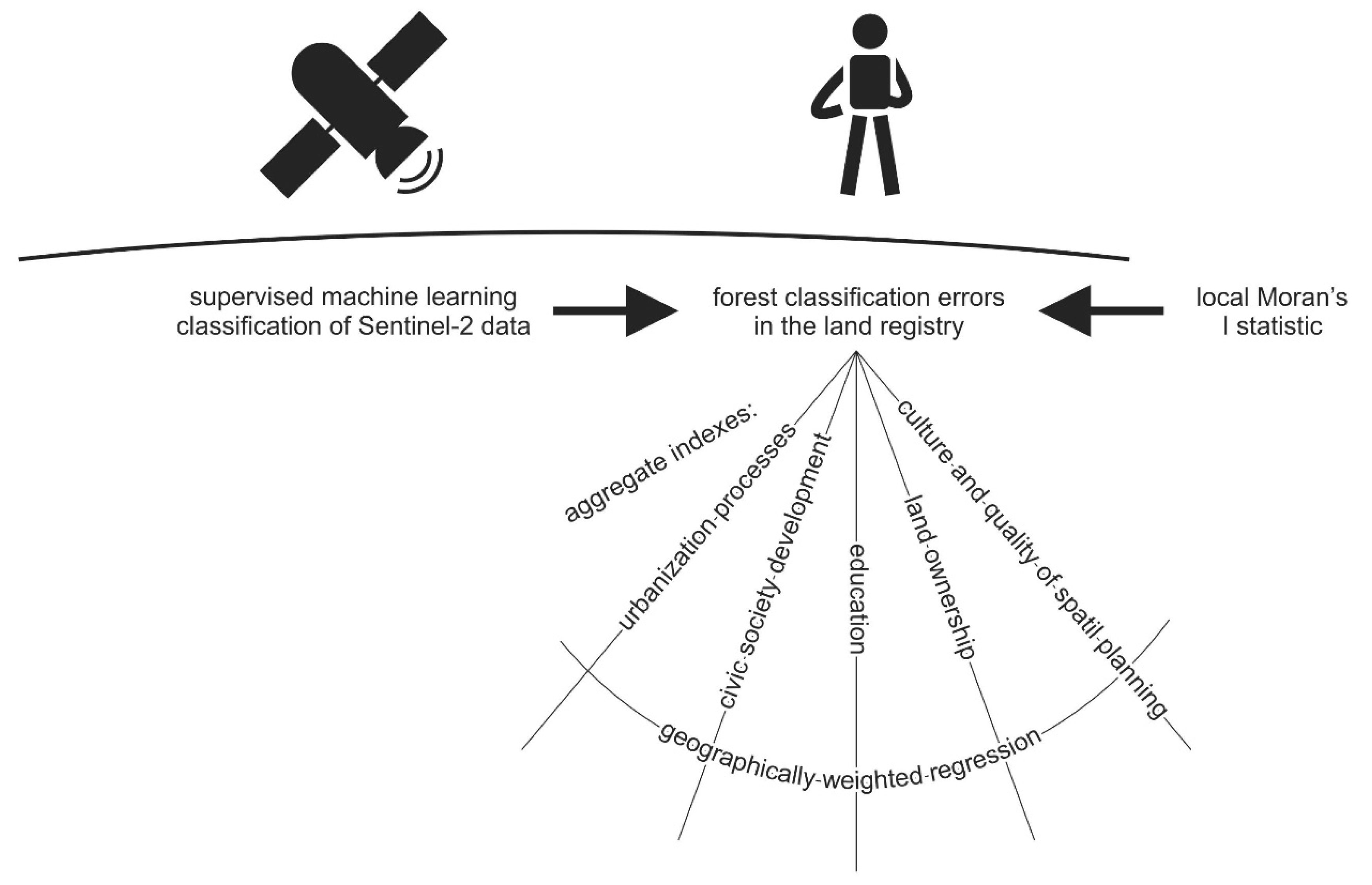

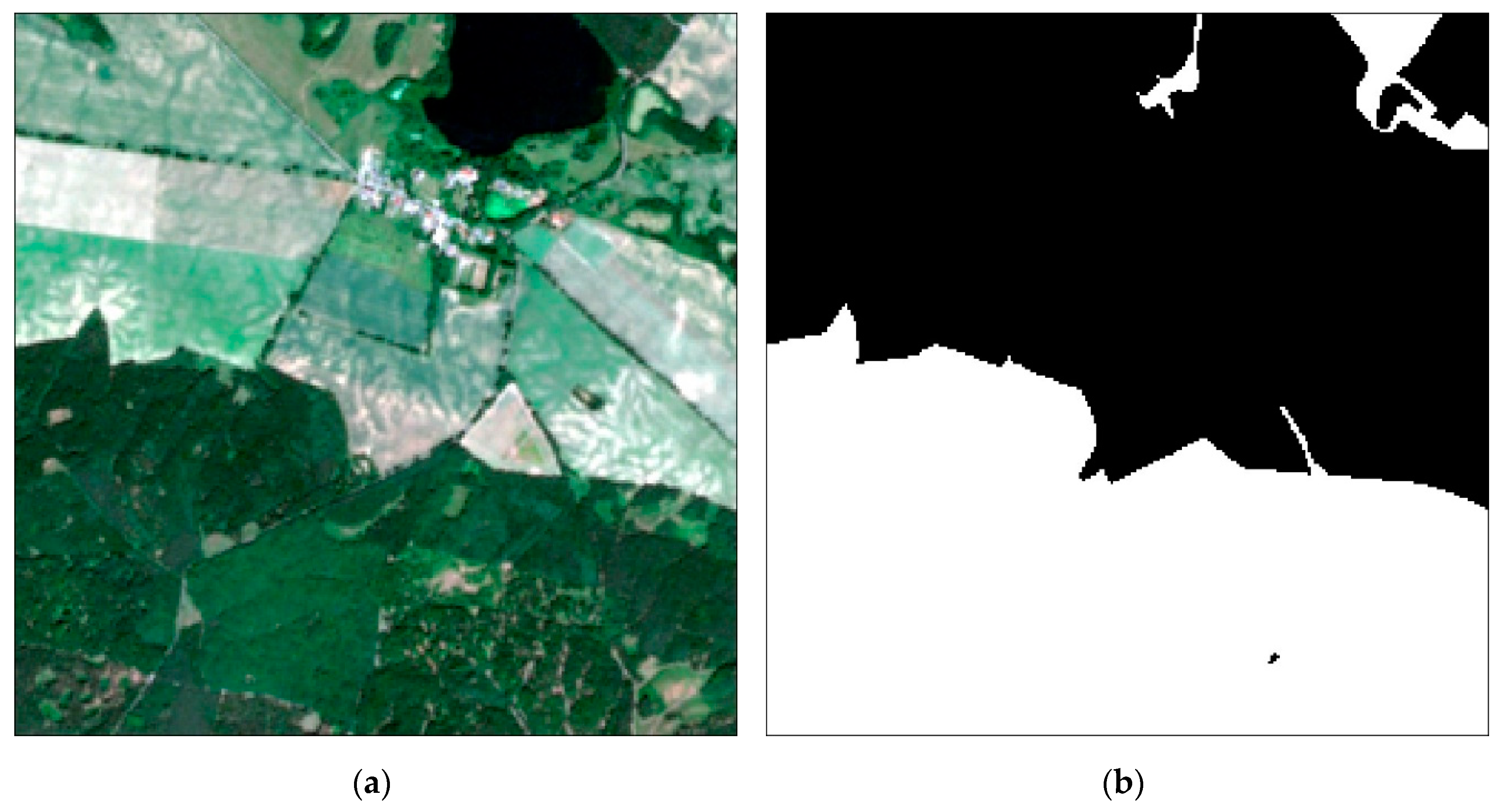
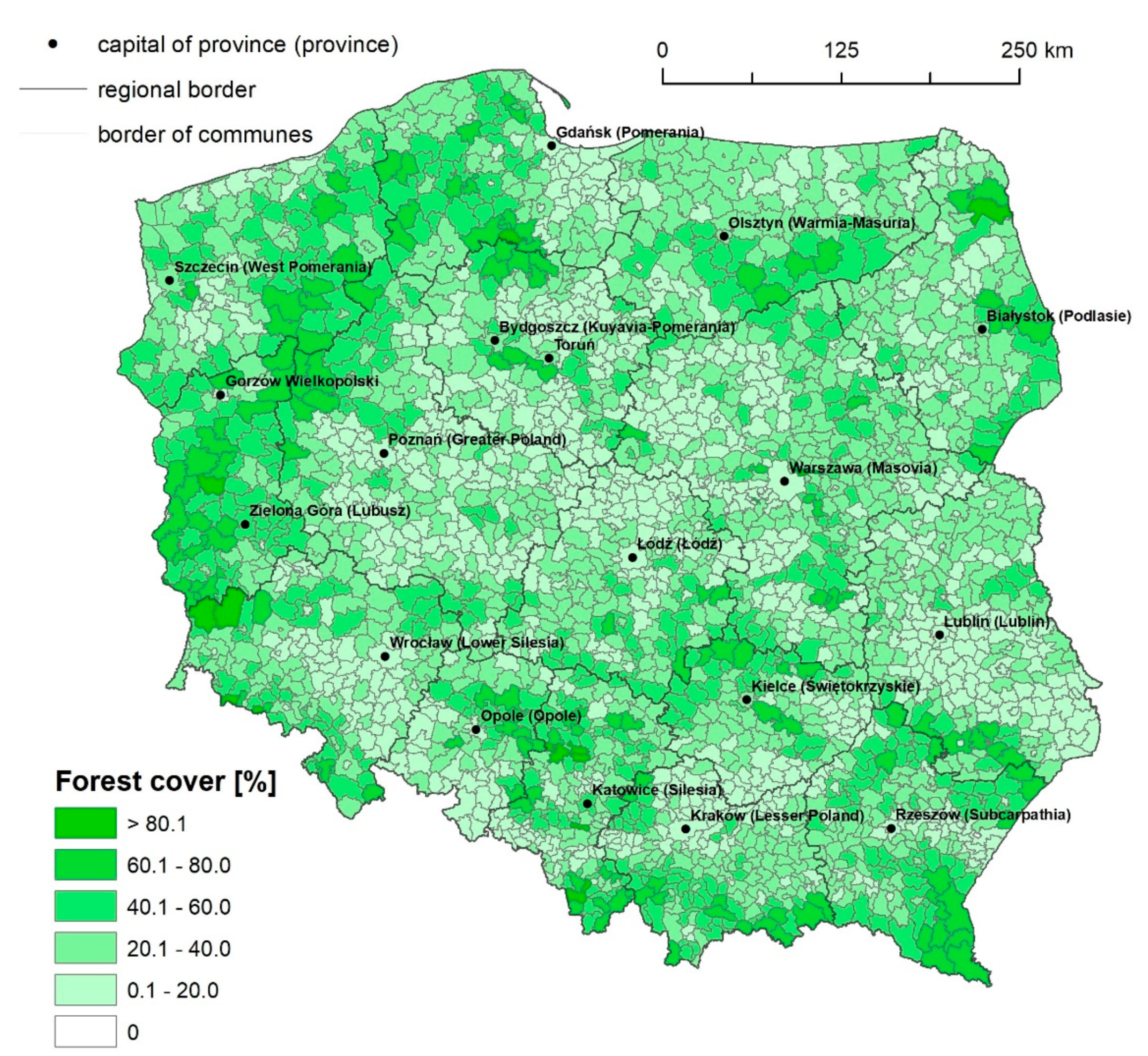
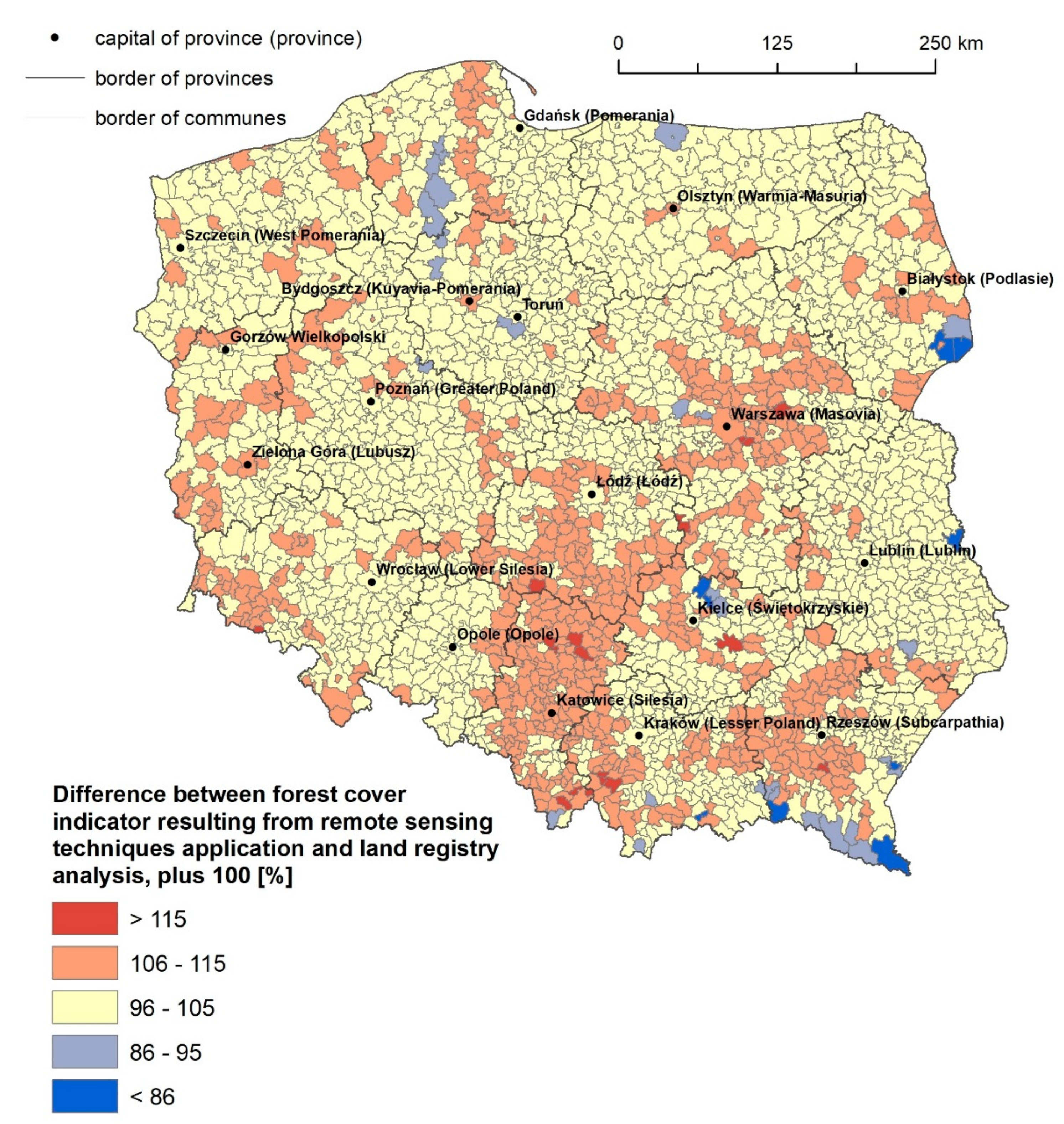
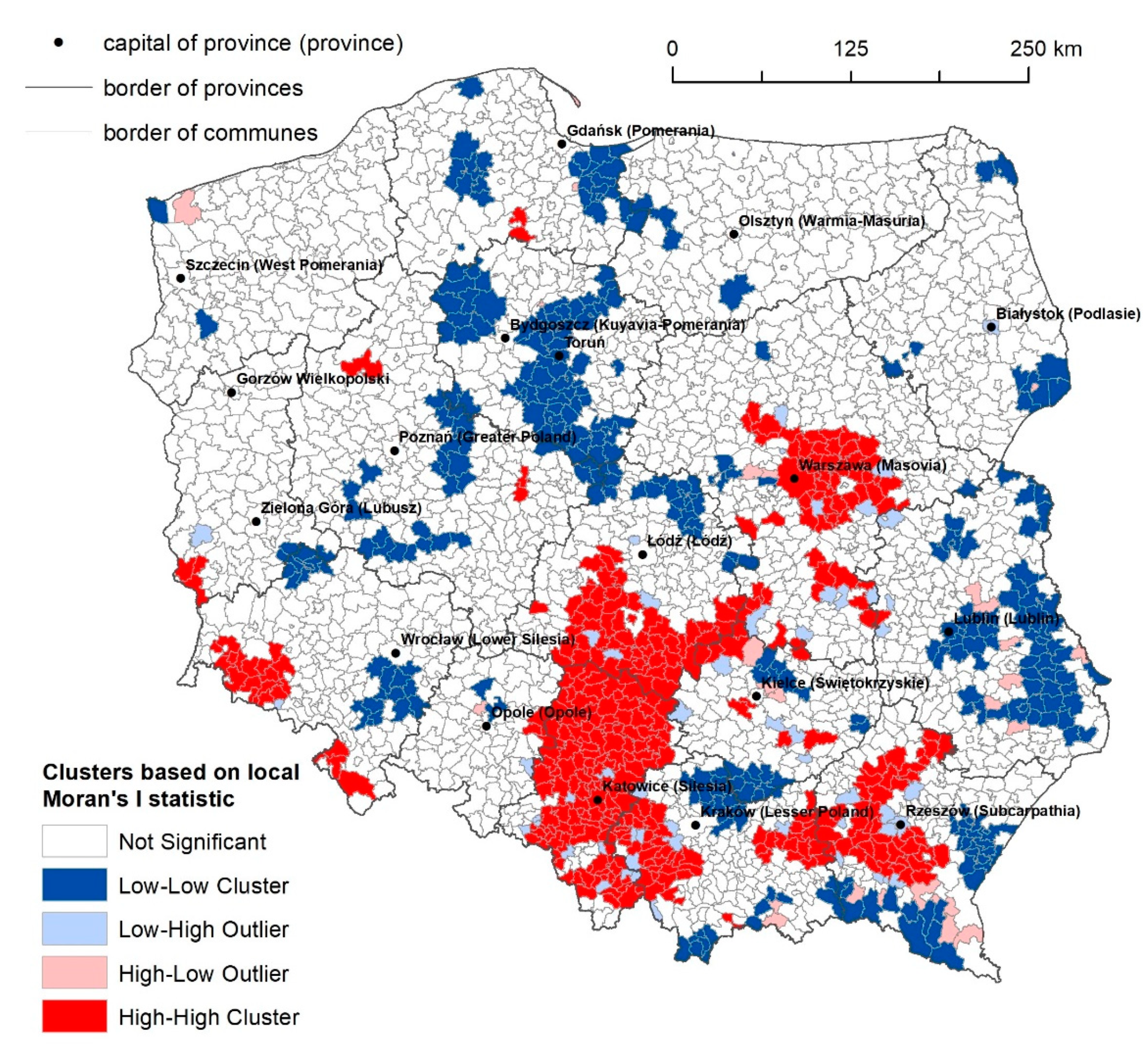

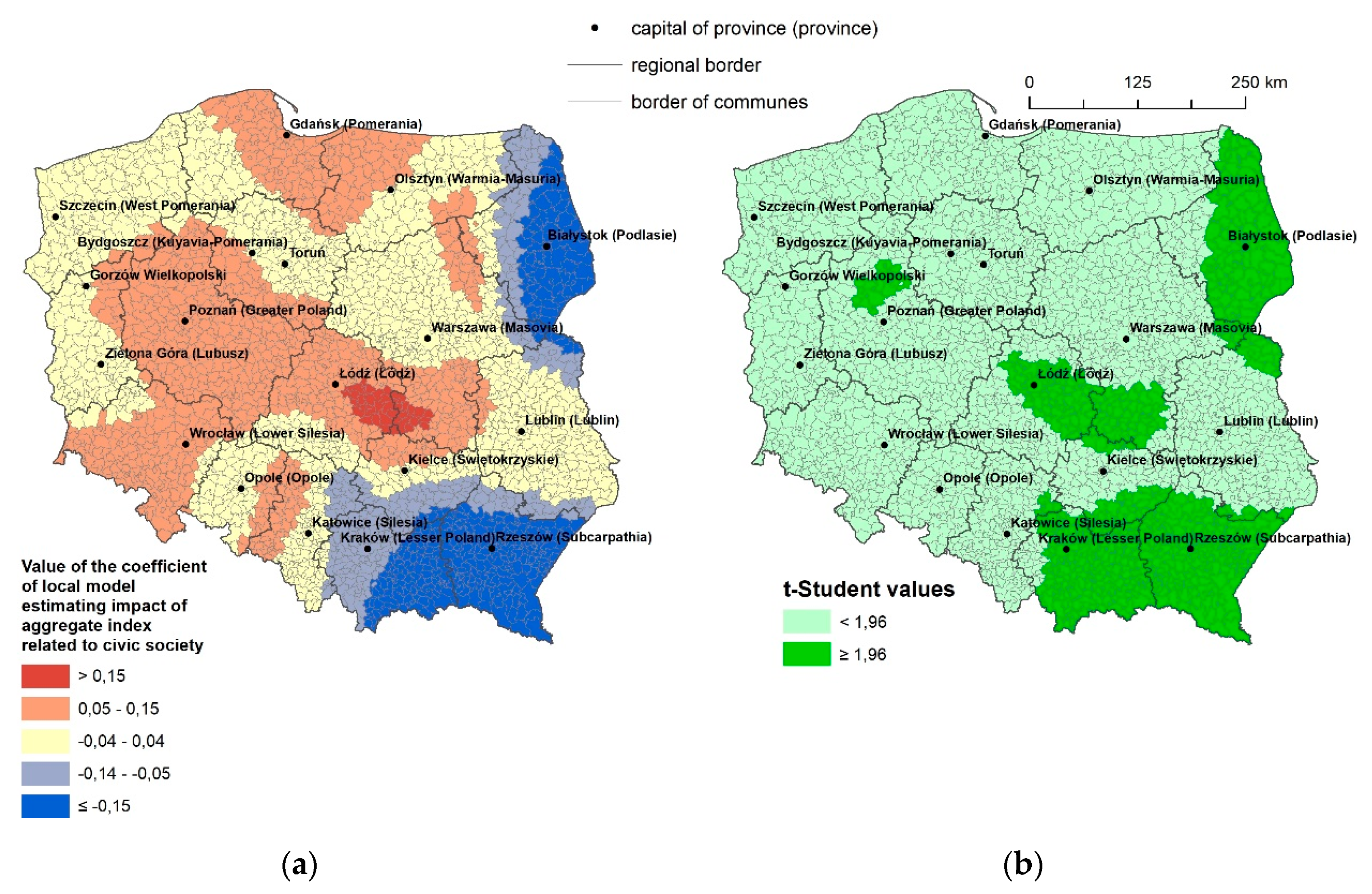
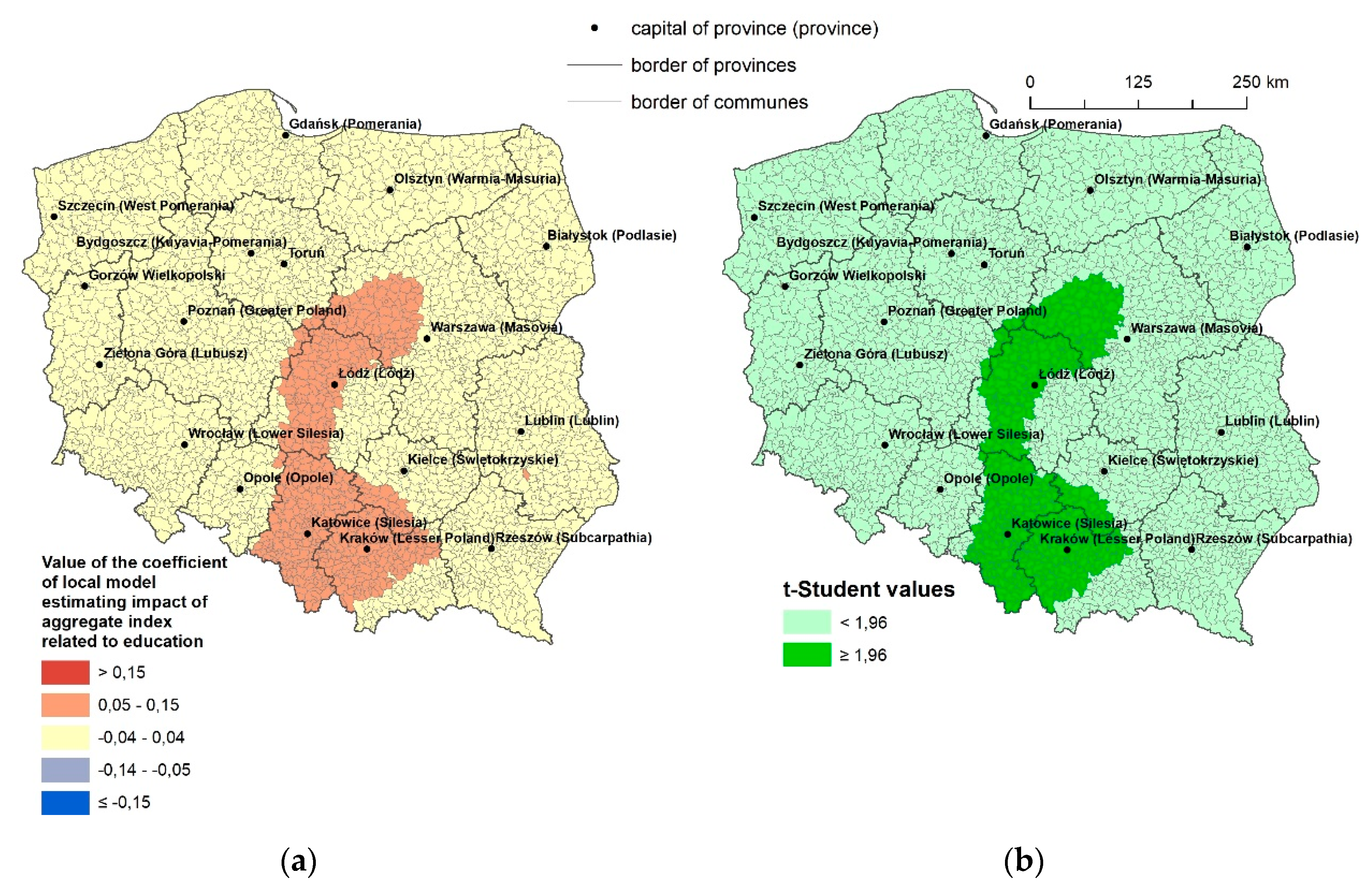

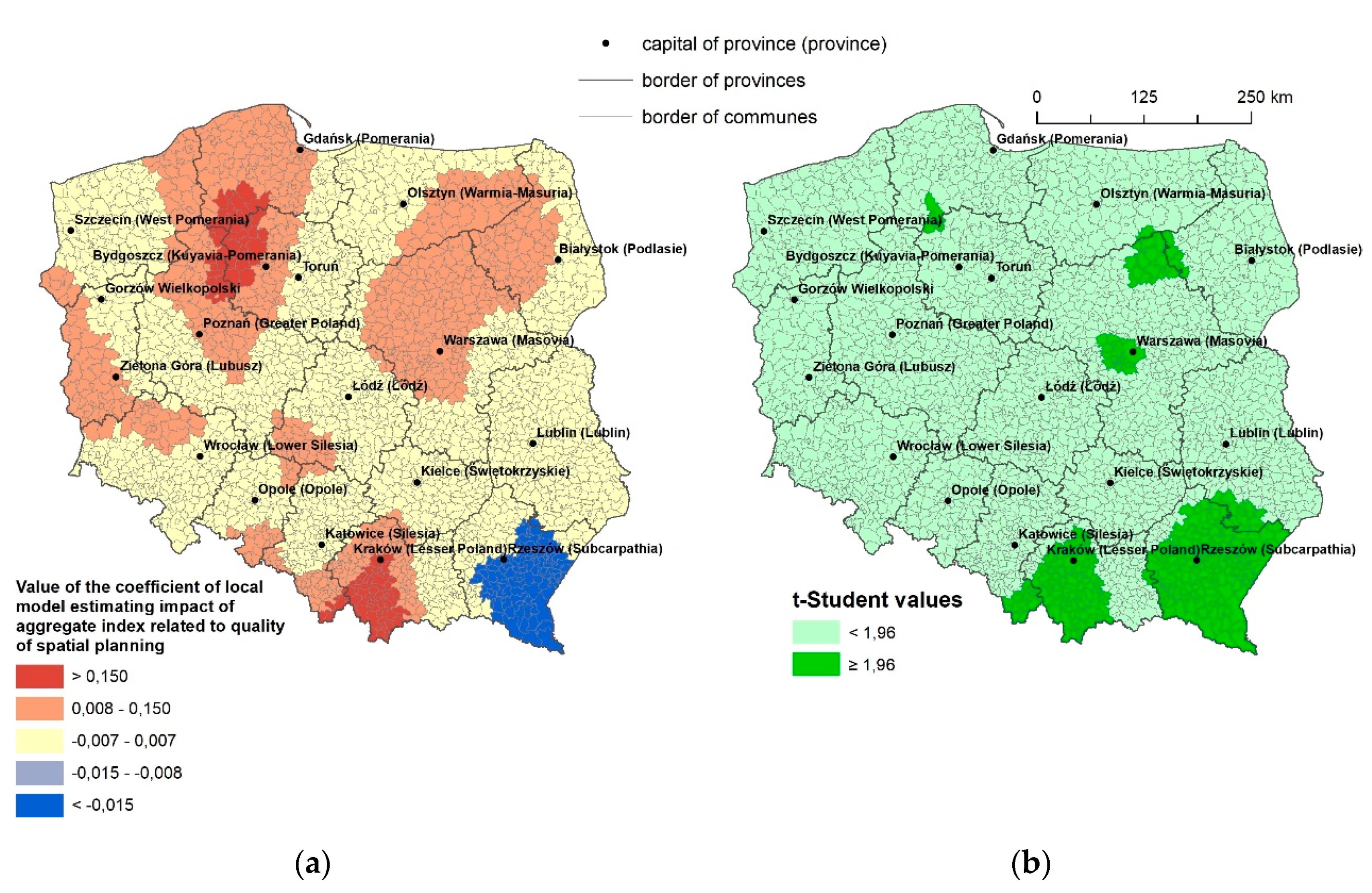
| Variable (Abbreviation) | Hypothesis | Measure | Data Source [2018] |
|---|---|---|---|
| Urbanization processes (URBAN) | H1 |
| BDL |
| BDOT | ||
| Civic society development (CIVIC) | H2 |
| BDL |
| BDL | ||
| PKW | ||
| Education (EDU) | H3 |
| BDL |
| BDL | ||
| Land ownership (LDOWN) | H4 |
| BDL |
| Culture and quality of spatial planning (SPPLAN) | H5 |
| BDL |
| Variable | Average | Standard Deviation | Minimum | Maximum | Coefficient | p-Value |
|---|---|---|---|---|---|---|
| FORESTCE | 103.48 | 4.10 | 52.50 | 128.44 | – | – |
| Intercept | – | – | – | – | 103.703 | →0 |
| URBAN | 4.24 | 5.07 | 0.02 | 65.90 | –0.004 | 0.843 |
| CIVIC | 34.30 | 5.16 | 2.69 | 68.13 | –0.033 | 0.036 |
| EDU | 26.63 | 10.75 | 1.67 | 73.33 | 0.033 | →0 |
| LDOWN | 63.52 | 30.57 | 0.00 | 100.00 | –0.005 | 0.080 |
| SPPLAN | 35.99 | 39.84 | 0.00 | 100.00 | 0.010 | →0 |
© 2020 by the authors. Licensee MDPI, Basel, Switzerland. This article is an open access article distributed under the terms and conditions of the Creative Commons Attribution (CC BY) license (http://creativecommons.org/licenses/by/4.0/).
Share and Cite
Adamiak, M.; Biczkowski, M.; Leśniewska-Napierała, K.; Nalej, M.; Napierała, T. Impairing Land Registry: Social, Demographic, and Economic Determinants of Forest Classification Errors. Remote Sens. 2020, 12, 2628. https://doi.org/10.3390/rs12162628
Adamiak M, Biczkowski M, Leśniewska-Napierała K, Nalej M, Napierała T. Impairing Land Registry: Social, Demographic, and Economic Determinants of Forest Classification Errors. Remote Sensing. 2020; 12(16):2628. https://doi.org/10.3390/rs12162628
Chicago/Turabian StyleAdamiak, Maciej, Mirosław Biczkowski, Katarzyna Leśniewska-Napierała, Marta Nalej, and Tomasz Napierała. 2020. "Impairing Land Registry: Social, Demographic, and Economic Determinants of Forest Classification Errors" Remote Sensing 12, no. 16: 2628. https://doi.org/10.3390/rs12162628
APA StyleAdamiak, M., Biczkowski, M., Leśniewska-Napierała, K., Nalej, M., & Napierała, T. (2020). Impairing Land Registry: Social, Demographic, and Economic Determinants of Forest Classification Errors. Remote Sensing, 12(16), 2628. https://doi.org/10.3390/rs12162628








